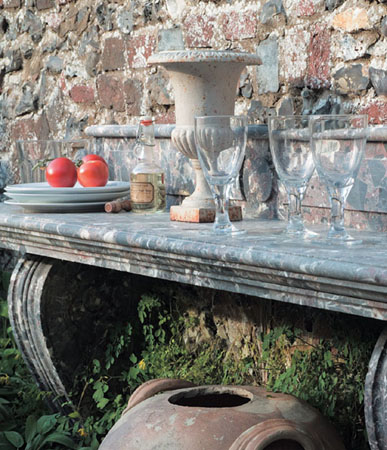

A beautiful, old, and very large marble fire surround found in an architectural reclamation yard has been put to ingenious use as a garden console table. Even a partly broken fireplace can be placed along a garden wall like this, because any flaws can easily be disguised with judicious planting.
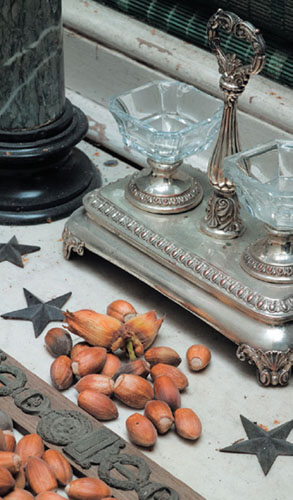
Handfuls of hazelnuts are thrown among neo-classical raised stars, which were used for furniture decoration. It is traditional to gather the fruit and nuts that grow wild in the château gardens.
The garden of the French château is particularly formal. It is geometric and symmetrical and, to appreciate the shapes, it is best seen from a high window. The style is derived from medieval knot gardens, where flowers were contained in shapely borders edged with rows of hedging. The French developed a more architectural form of the knot garden, called the parterre, by creating interlocking shapes using only green box plants. Simple rectangles and maze-like plantings evolved into arabesques and rococo curlicue designs. Plants with different colored leaves were used to enhance the pattern, giving an effect from above of raised green embroidery. From the ground shapely topiary hedges were visible in the form of cones, pyramids, and spheres. There were very few flowers; instead, geometrically shaped lakes and fountains along with tall classical statuary gave grandeur. This was the taming of the countryside, in spite of the French love of nostalgic pastoral scenes on their fabrics.
FORMAL SPLENDOR
This neo-classical architectural style is the form of gardening that has triumphed in France and the formality was echoed in the garden room. The greatest example of combining garden and room is to be seen at Versailles. Claude Mollet developed the formal parterre in the 18th century and it was used at Versailles under the guidance of André Le Nôtre, who designed and laid out the gardens. His designs included an orangery, a building somewhere between a garden room and a sunroom, where exotic warmth-loving fruit, such as, oranges were grown.
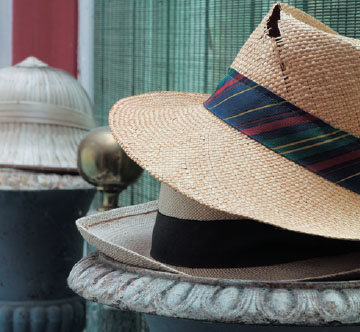
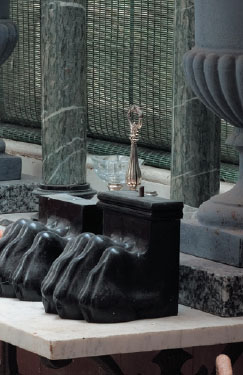
In a garden room, an intriguing collection of neo-classical architectural pieces sits on an old French metal-framed table. The various objects are laid out symmetrically, in keeping with the formal parterres of the château, but there is a touch of whimsy here with the old garden hats, the hazelnuts, and the wire basket of shells.
The manoir garden is as like the garden of Versailles as the owner could make it—formal and symmetrical, filled with greenery and possibly a few architectural features. Often this would simply be a tall front wall with an imposing main gate opening on to a central, straight path or driveway leading to the front of an equally symmetrical house.
There may be rows of trees and gravel pathways but never more than a few flowers. While low boxwood hedges might develop into parterres, any trees would be vigorously pruned so that they can be kept in the right architectural form. Yews, box trees, hornbeams, and cypress trees were popular species because they could be easily pruned and shaped.
THE KITCHEN GARDEN
Behind the house would be the most important area—the kitchen garden, where all the vegetables and fruit for the house would be grown. This would be kept in the same symmetrical and well-ordered manner as the rest of the garden.
The more rustic your own yard, the more suitable it becomes as a kitchen plot. Fruit trees—such as apples, pears, and a variety of plums and greengages, including the French “Reine Claude”—are the trees of the north. Farther south they are replaced by vineyards.
Of course, the French countryman loves flowers too but they will usually be confined to those needing little attention. His heart and mind will be with the plants that can provide good flavors for his table. One of the most robust and popular flowers is the ubiquitous brilliant red or pink geranium, as any journey through France will indicate—they can be seen in window boxes and pots in every village and farmyard. Hydrangeas are probably the second most popular plant. These thrive on the shady side of the house and by water. Lily-of-the-valley is an old favorite and will often be found in French country gardens. It is traditionally handed out at special events, and its sweet perfume makes it very popular for bridal arrangements.
Use ginghams and flowery fabrics, metal tables and chairs with delightful curvy backs and arms. Kitchen enamelware is simply brought out into the garden when eating outdoors.
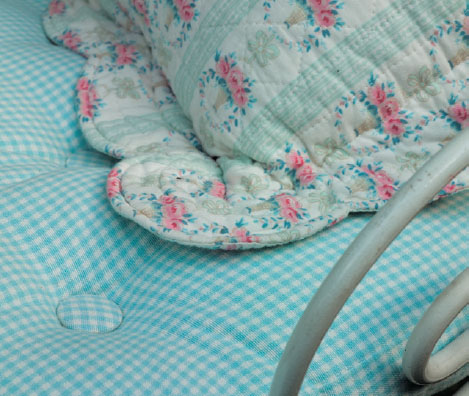
These curvy metal chairs and the table with the pierced holes are the epitome of French outdoor living. Collect French kitchenware, such as the white enamelware sugar sprinkler on the table here—enamelware was used particularly for coffee pitchers and other containers. The quilting of flowery fabrics, as used for this pillow, originated in the south but has spread all over France and is used when a country look is required.
The difference in climate between the north and the south of France is quite significant. A Provençal garden revolves around lavender, herbs, and sunflowers, olive trees and grapevines. In more northerly climates, an indoor garden room with under-floor heating ensures that at least some of these plants can be accommodated even in the coldest temperatures.
Use gravel in the garden with big terra cotta pots, painted chairs and tables, and soft fabrics. Have big shutters on the outside of the house and paint them the beautiful fresh blue or green you find in the Mediterranean, perhaps against an ocher-colored wall. The kitchen garden remains important, with basil and rosemary to go with tomatoes, peppers, and all the other Mediterranean vegetables.
PROVENÇAL INSPIRATION
For inspiration, discover the garden of olive trees and orange groves at the artist Renoir’s home in the South of France. Another impressionist, Claude Monet, had a famous house and garden in Giverny, near Paris. Despite being in the north, both the house and garden were inspired by Provence. To bring out the shades of the garden and to make it appear bright and colorful, Monet used combinations of complementary colors, so wherever there is an orange there is also a blue, and purple lavender or iris is matched with nearby yellow or orange companion plants. The house is painted pink with green shutters and woodwork, just as if it was in Provence.
The nearer the Cote d’Azur the more exotic the planting can be. Oranges and lemons, figs, avocado, bananas, and palm trees grow alongside bright colored flowers, including purple bougainvillea and pink weigela. Many shrubs and trees have gray green leaves, indicating the lack of rain in the area. In your Provençal garden room, reflect these Mediterranean color in napkins and tablecloths, and in the color you paint your furniture.
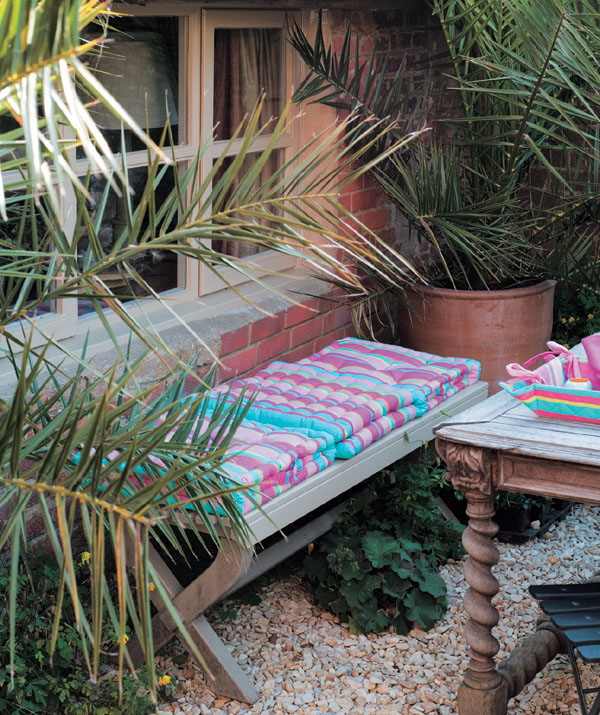
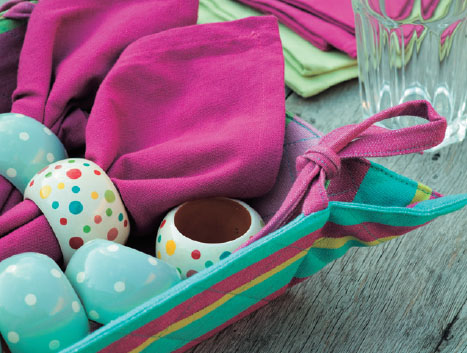
Create the Riviera look with bright striped pillows and palm fronds. Vibrant purples and pinks are the colors of creeping bougainvillea. Combined with the azure blue of the sea these are great colors for napkins. Spots and stripes conjure up the carefree outdoor life of the south of France.
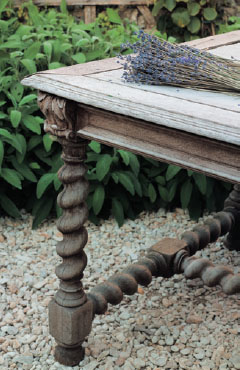
This old oak table has been out in the garden for years, and is alternately soaked with rain and dried out in the sun. Now bleached gray, the wood’s beautiful patina suits the dry, smoky colors of lavender, rosemary, and sage.
Colorful pots of banana plants lined up in a black metal planter give a city garden an exotic look. This sort of wirework planter used to be very popular in France and many different types can be found, sometimes painted in white or blue. With a coat of derusting solution to protect them, they can be given a new lease of life.
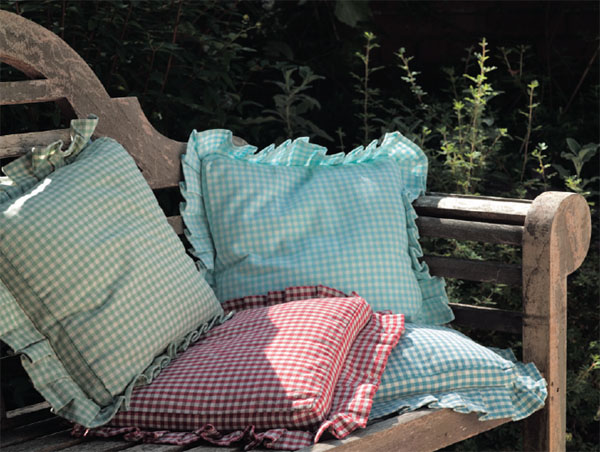
Gingham pillows with pretty ruffled edges—what could be more French?
In Paris, greenery and flowers nestle in quite unexpected places. Trees poke out over rooftops, large window boxes overflow with greenery, and glass-covered balconies are filled with tropical abundance. Peek through elegant open doors while wandering the streets of Paris to catch a glimpse of perfect little courtyard gardens with formal planting in stone pots. Bay trees cut in the shape of cones or balls are a wonderful way of embellishing a small courtyard garden. A stone bench, statue or small fountain inset into the wall are not unusual. These formal areas take inspiration from the city’s historic gardens, such as the Jardin des Tuileries, first laid out with elegant and symmetrical parterres by the same gardener who designed Versailles. Dine outside in the evenings with candelabra on a white tablecloth.
COUNTRY IN THE CITY
A Parisian garden contains a little of every French style. The countryside is brought into the city with shapely wooden benches and simple pillows. Find pots and tubs for herbs and climbing vegetables, such as French beans. Paint odd containers, such as old tins and watering cans, then fill them with red geraniums and hydrangeas. Fill wall-mounted wire planters with pots and search flea markets for reproductions of the traditional freestanding wrought-iron planters. Bohemian chic is never far away in Paris. Paint a cupboard for your garden tools and mix French country style with urns and mirrors for an haute couture look.
Bring the aroma of Provence into your garden with big pots of lavender and lemon verbena. Grow Provençal culinary plants such as tarragon, basil, and rosemary. Put gravel down to give the feeling and sound of the Luberon. An olive tree, if sheltered and in a sunny position, will thrive and provide the appropriate shade of gray green. A grapevine, given enough sun and a big enough pot, will grow brilliantly and may even bear fruit. With candles in lanterns at night you will be transported to Provence.
In France, rattan and bamboo furniture would have been painted white or in pale summery colors and set out in a garden room or orangery. Due to its rough surface, it is not quick to paint so, before you start, decide if you are going to cover the piece or just skate over the surface—here you can still see bamboo peeping through. A favorite method of the 18th century was painting seats in a checkered pattern. I have used three colors—a duck-egg blue base, a blue green, and finally white. This sort of chair looks quite at home in a smart garden room.
YOU WILL NEED
Wood adhesive
100 ml two colored
Chalk Paints
Large paintbrush
100 ml Old White
Chalk Paint
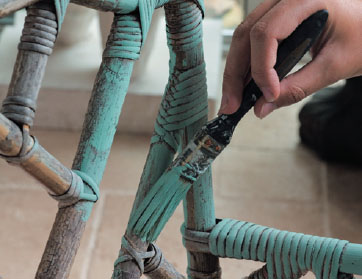
1 First mend any of the fine rattan strands that are broken by gluing them in place. Paint the chair in Duck Egg Blue with the tip of the brush, working over the same area several times. Each time you recharge your brush, put the first dollop of paint on an area bound with rattan as this will take more paint and help to create even coverage.
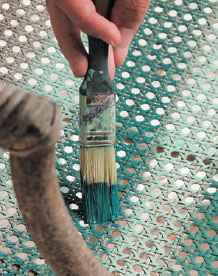
2 Paint the seat base in alternate stripes of Duck Egg Blue and Château Grey, allowing each to dry thoroughly before proceeding with the next color.
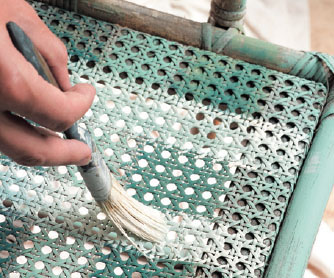
3 Finish with a stripe of white painted in the opposite direction, leaving gaps of equal width between each stripe to allow the crossing stripes to show through.
It is the odd symmetry of the toile de Jouy fabrics that makes these pillows so charming. Collect left-over pieces of fabric or find remnants and base the color of your pillow on the central design—the pastoral scenes of toile de Jouy give an excellent focus. There are two pillow designs here—one with five panels using four fabrics, the other with nine panels and five fabrics. Surrounding the patterned fabrics are at least two that are plain or have a simple stripe or check, while an outer strip adds a contrasting pattern.
YOU WILL NEED
Selection of fabric remnants
Scissors
Pins
Needle and cotton
Zipper
Pillow forms
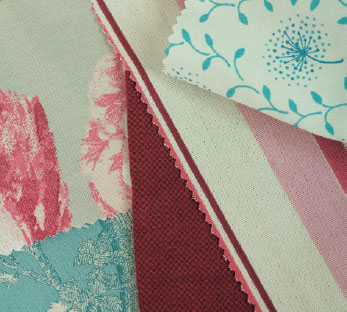
1 Find a collection of fabric pieces that work together in color and design. These pillows use a toile de Jouy fabric in the center, with stripes, although plain or abstract patterns could equally well have been used.
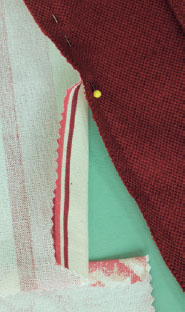
2 Cut out the pieces of fabric in either square or rectangular shapes, just as you wish, with an overlap of about 2 in., and then pin them together.
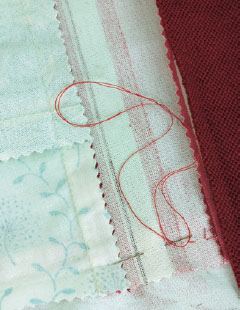
3 Fold over the edges and, working from the back, tack then sew the pieces of fabric together. Join the patchwork to a plain piece of fabric for the reverse of the pillow, fixing a zipper down one edge.
YOU WILL NEED
2 tsp pigment
Spoon and bowl
250 ml thick natural yogurt
Medium paintbrush
Making paint using yogurt or curdled milk as a binding agent for pigment is an old, rural technique for putting a glut of milk to good use. The first thought is that it will smell, go moldy or come off on your clothes but, in fact, none of these things occur and, in the right mixture, the paint is completely stable. This chair was painted with a deep green pigment some years ago and has aged and distressed in an extremely lovely way without being varnished or waxed.
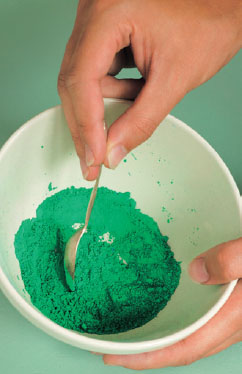
1 Put the pigment in a bowl and break it down into a fine powder with a spoon. The exact quantities of both pigment and yoghurt are difficult to give as each pigment is of a different strength.
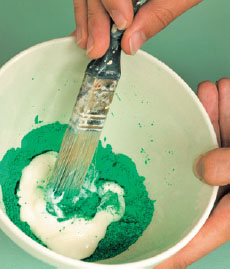
2 Add the yogurt to the pigment and stir around with the spoon until the mixture has a smooth consistency and can be applied with a brush. The yogurt is the adhesive that binds the paint together, making it stick to the furniture.
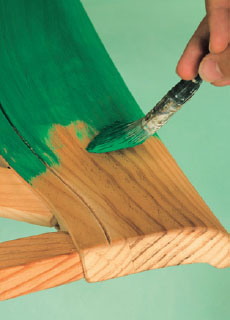
3 Test the mixture on a small hidden area of the chair to see how stable it is when it dries—since the paint is so basic, it will take a very short time to dry. If that works, then paint the rest of the chair. Not using primer will result in the wood looking distressed and worn almost immediately.
Bohemian Paris has a tradition of light and decorative painting, so where better to display it than on painted furniture? Although the method is very loose, the design needs some planning to give the piece unity. Here, the drawers have been treated as individual panels and the two sides each show a vase of flowers.
YOU WILL NEED
Plain wooden cabinet
500 ml Paris Grey Chalk Paint
Large paintbrush
100 ml each of six Chalk Paints
Small, round-headed paintbrush
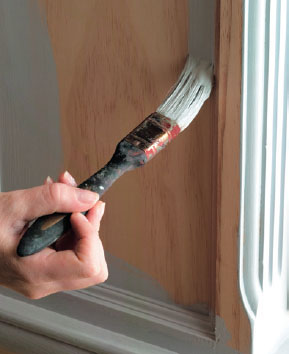
1 Paint the cabinet gray all over. This neutral, mid-tone can have both light and dark colors successfully worked in to it.
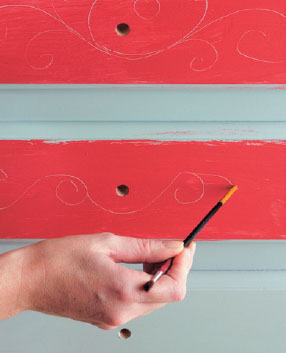
2 Paint the front of the drawer facings in red, then use the end of a brush to work through the wet paint as if you are drawing to reveal the gray base coat underneath. Work quickly before the top coat dries but, if you do not like what you have done, simply go over it with another coat of paint and try again.
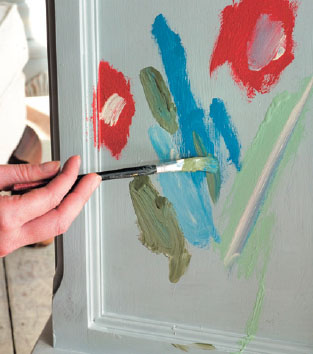
3 On the side panels use different brushstrokes to make the impressionistic stripes and spots of a bunch of flowers. Mix the brushstrokes with incised lines to create a variety of colors and effects.